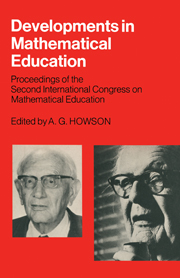 Developments in Mathematical Education
Developments in Mathematical Education Book contents
- Frontmatter
- Contents
- Editor's Acknowledgements
- PART I A CONGRESS SURVEY
- PART II THE INVITED PAPERS
- PART III A SELECTION OF CONGRESS PAPERS
- Investigation and problem-solving in mathematical education
- Intuition, structure and heuristic methods in the teaching of mathematics
- Mathematics and science in the secondary school
- Geometry as a gateway to mathematics
- The International Baccalaureate
- The role of axioms in contemporary mathematics and in mathematical education
- Implications of the work of Piaget in the training of students to teach primary mathematics
- Are we off the track in teaching mathematical concepts?
- Appendices
- Index
Intuition, structure and heuristic methods in the teaching of mathematics
from PART III - A SELECTION OF CONGRESS PAPERS
- Frontmatter
- Contents
- Editor's Acknowledgements
- PART I A CONGRESS SURVEY
- PART II THE INVITED PAPERS
- PART III A SELECTION OF CONGRESS PAPERS
- Investigation and problem-solving in mathematical education
- Intuition, structure and heuristic methods in the teaching of mathematics
- Mathematics and science in the secondary school
- Geometry as a gateway to mathematics
- The International Baccalaureate
- The role of axioms in contemporary mathematics and in mathematical education
- Implications of the work of Piaget in the training of students to teach primary mathematics
- Are we off the track in teaching mathematical concepts?
- Appendices
- Index
Summary
Intuition and comprehension in mathematical education
When the pupil is presented with a logical proof, is it necessary for him to have to add to this his own means of direct comprehension, that is to say, what is known as his intuition?
This is not a new problem. However, it has recently attracted much attention due to the increase in rigour of the mathematical proofs given in teaching situations. In my opinion, in order that these more axiomatised demonstrations do not stifle the mathematical reasoning process, it is absolutely essential to encourage the use of such intuitive support. This is the first problem that I should like to examine.
First, I consider that there are a number of distinctions that should be made: it is necessary to distinguish between what I call intuitions of adhesion and intuitions of anticipation. The intuition of adhesion expresses itself in the feeling of evidence about a certain fact. It is intuitively evident that the relation of equality is transitive, that from any point not on a straight line there can be only one perpendicular to that line, that there is always a natural number greater than a given number, etc. When I say that something is ‘intuitively evident’ I refer to the fact that the need for a mathematical proof is not felt in these cases (though, from the mathematical point of view, such a proof may be necessary).
- Type
- Chapter
- Information
- Developments in Mathematical EducationProceedings of the Second International Congress on Mathematical Education, pp. 222 - 232Publisher: Cambridge University PressPrint publication year: 1973
- 6
- Cited by
